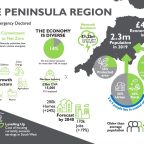
Protecting your business against flooding
As we are all unfortunately very aware, Exeter is a high-risk area for flooding. As far back as 2012, the city was named the 15th most at risk location by the Association of British Insurers, and since then each winter has brought more scenes of devastation. A £32m flood-defence scheme was begun in 2014 and went into its second phase last summer. Work has now stopped until October to avoid disruption to summer visitors, but the government still hopes to have the scheme completed in 2018.
In the meantime, however, Exeter's businesses still face the prospect of flooded premises, ruined stock, damaged assets and costly interruptions to their day-to-day activities. That's why it's imperative to know how to protect your livelihood from flooding as much as possible while waiting for a comprehensive long-term solution to be implemented.
Stay alert
The first thing local business owners should do is to sign up to receive free, 24-7 flood warnings from the Environmental Agency that could give you crucial extra hours to prepare by moving stock and getting your flood defences in place.
Undertake a full risk assessment
Don't wait for the rainy season to arrive before you start to consider the risks your business faces. Undertake a full inspection of your premises as soon as possible and look for the most at risk areas. This could mean the parts of your business premises most likely to be flooded, but also the areas or items that would be most damaged by flooding, or that would cause the most disruption if out of action.
Prepare a flood plan
Once you've written up the results of your risk assessment and taken steps to minimise these risks, you need to put together a written plan of what to do should the worst happen. As a business, your chief concern should be business continuity, with as little interruption to your regular business practice as possible. Ideally, you should have a secondary location that stock and equipment can be moved to if a flood is imminent. If this isn't possible then items should be moved to an upper floor or even a high shelf. Prioritise which items need to be moved first.
Have the correct equipment
You'll be able to recover from a flood a lot quicker if you have the necessary equipment to get rid of floodwater as soon as possible. To swiftly remove water, you can hire a submersible pump which is an electric pump designed to work when submerged. Be sure to get one with a filter to stop it being blocked by debris.
Secure the property
Any items that could float on the floodwater and cause further damage should be carefully secured, and all utilities (gas, water, electricity) should be turned off. A temporary toilet pan seal should be fitted to stop a backflow of foul water. Use a silicone sealant to make external doors and windows watertight, but if the floodwater reaches a height of 1m or more, then it should be allowed to enter to prevent structural damage. Similarly, internal doors should be left open or removed entirely.
Keep everyone informed
Your flood plan should include up to date contact numbers for everyone you will need to reach in the event of a flood. This should include your insurers as well as government and emergency services. Remember to cancel all deliveries to the flood-hit premises, and to try to get as many of your own deliveries out before the flooding hits.
All of your employees and partners should know what to do in the event of a flood. It's vital that all concerned stay calm and carry out their agreed roles. Establish an appropriate evacuation point and let employees working in other locations know if the main premises have been flooded so they do not come in.
With flood damage in the UK estimated to have cost over £5bn at the end of 2015, it's vitally important that businesses know how to manage their own risks. The average cost of flood damage to a small business is estimated at £28,000, which is a sum that few can afford to lose. Even if your company is fully insured, it can take time for payments to come through and repairs to be carried out, and you need to get back on your feet and trading again as soon as possible. That's why it's essential to minimise your risks and to try to make sure that as little damage is done to your business by flooding as possible.




















